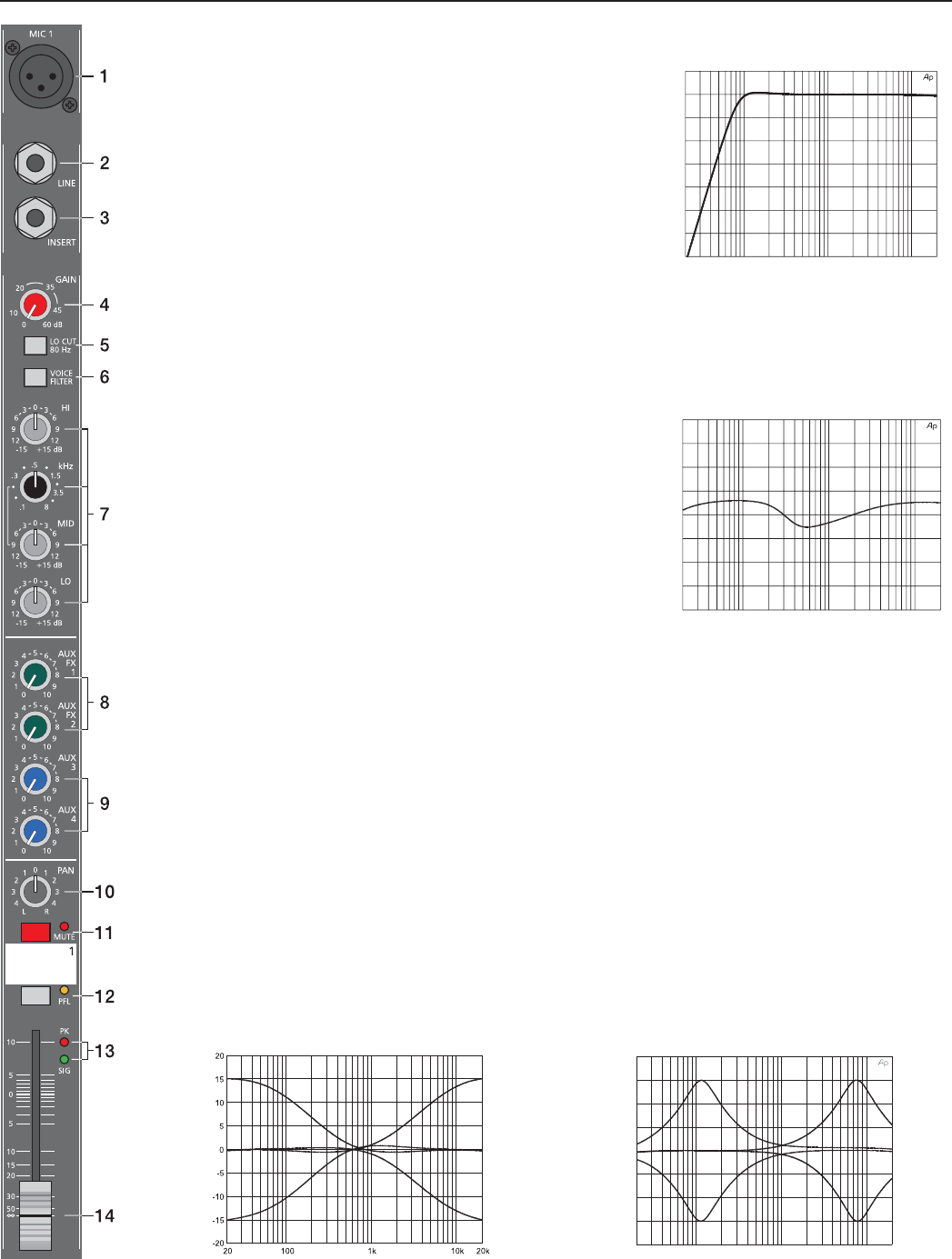
INPUT MONO
5. LO CUT 80 Hz
When the LO CUT switch is engaged, frequencies below 80 Hz are
attenuated (18dB octave slope). In most cases it is good advice to
use the LO CUT fi lter with microphone channels, since it effi ciently
suppresses popping sounds, rumbling noise and low-frequency
feedback. The only exceptions are kick drum and bass. Sometimes
it can be also very effective to combine the LO CUT fi lter with the
voicing fi lter, for instance to provide vocals with more “body”, without
getting additional low pitched noise. Activating the LO CUT and
raising the bass level (LO EQ) provides you with a richer sound,
without additional rumbling or low-frequency popping noise. Another
welcome side effect is, that the power amplifi er and the loudspeakers
connected to your sound reinforcement system do not get “polluted” with unnecessary low-pitched interference.
Your audience will be thankful for the use of the LO CUT fi lter, too, since in this way they can enjoy a truly clear,
natural, and powerful sound performance.
6. VOICING FILTER
This button activates a special asymmetric microphone fi lter, which
can be used in addition to the channel EQ. The voicing fi lter enhances
the fi rst harmonic oscillation and the treble of the human voice while
slightly attenuating the mid frequency range. This voice shaping
method provides powerful vocals that are clearly emphasized from
the rest of the mix. Ordinary third or octave band equalizers do not
provide this kind of “pre-shaping”. The use of this fi lter is not restricted
to vocals only. Horns, woodwinds, and other acoustic instruments can
profi t from the voicing fi lter as well. We leave it entirely up to your
creativity and imagination to try the VOICE fi lter with as many different
sound sources, as you want.
Normally, you do not have to fear any problems with the occurrence of feedback.
7. EQ Section
The mixer’s EQ section allows very differentiated shaping of the incoming audio signal within miscellaneous
frequency bands. Turning one of the EQ level controls to the right enhances/amplifi es the corresponding
frequency range while turning it to the left lowers/attenuates the signal of that specifi c frequency band. Before
you begin to alter the sound, all EQ controls should be set to their neutral position, i.e. their marker points
straight up (locked in place). Try not to set the EQ controls to extreme positions. Usually, minor changes are
totally suffi cient and produce the best results in the overall sound. You should use the natural reproduction as an
orientation mark and rely on your musically trained ear. Moderate use of the MID control is the best remedy to
avoid acoustical feedback. Especially in this frequency range you should try to avoid excessive enhancement.
Lowering the level more or less in this band will provide you with high amplifi cation rates without feedback. Use
the LO control according to your pleasing, to add more “punch” to the sound of a kick drum or “body” to the
vocals. Use the HI control in the same way to provide cymbals and the human voice with more treble and a
more transparent sound. The MID EQ section offers parametric EQ-setting via separate rotary controls for the
adjustment of level (MID) and frequency band (kHz) in the range between 100 Hz and 8 kHz.
-35
-30
-25
-20
-15
-10
-5
0
5
20 100 1k 10k 20k
-20
-15
-10
-5
0
5
10
15
20
20 100 1k 10k 20k
-20
-15
-10
-5
0
5
10
15
20
20 100 1k 10k 20k
LOW/HI EQ
MID EQ
.1kHz & 8kHz
7


















